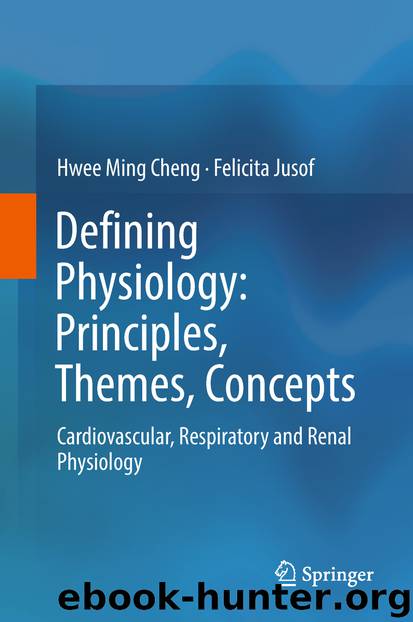Defining Physiology: Principles, Themes, Concepts by Hwee Ming Cheng & Felicita Jusof

Author:Hwee Ming Cheng & Felicita Jusof
Language: eng
Format: epub
Publisher: Springer Singapore, Singapore
11 Shunts in Respiratory Physiology
i.Definition: Generally, a shunt is an area or a situation where the ventilation that provides oxygenation does not take place.
ii.PTC
A shunt is commonly described in the textbooks as anatomical or physiological. This can be confusing for the students for several reasons.
A physiologic shunt in all normal persons refer to the slight mixing of some deoxygenated blood (from certain vascular branches of coronary, bronchial vessels) with the main bulk of oxygenated blood in the pulmonary veins. This leads to a minor drop in the PO2 comparing alveolar capillary PO2 at 103 mmHg and arterial PO2 97 mmHg. This normal PO2 difference in the physiologic shunt should be less than 15 mmHg and as described, is due to normal vascular anatomical connections.
Traditionally, an anatomical shunt indicates a major dilution of oxygenated blood with a significant portion of deoxygenated blood. An example is a septal defect in the heart, and considerable venous blood is shunted from the right to left side of the heart.
Within the lungs, an alveolar shunt represents an area where the airflow is blocked. The alveolar ventilation is nil and the pulmonary capillary blood flows pass a shunt. To avoid confusion, students might wonder at the anatomical dead ‘space’ where oxygenation also do not occur. From the definition given above, the conducting zone of the ‘dead’ space has ventilation, but there is no gas exchange.
Download
This site does not store any files on its server. We only index and link to content provided by other sites. Please contact the content providers to delete copyright contents if any and email us, we'll remove relevant links or contents immediately.
| Administration & Medicine Economics | Allied Health Professions |
| Basic Sciences | Dentistry |
| History | Medical Informatics |
| Medicine | Nursing |
| Pharmacology | Psychology |
| Research | Veterinary Medicine |
Tuesdays with Morrie by Mitch Albom(4691)
Yoga Anatomy by Kaminoff Leslie(4306)
Science and Development of Muscle Hypertrophy by Brad Schoenfeld(4089)
Bodyweight Strength Training: 12 Weeks to Build Muscle and Burn Fat by Jay Cardiello(3915)
Introduction to Kinesiology by Shirl J. Hoffman(3725)
How Music Works by David Byrne(3187)
Sapiens and Homo Deus by Yuval Noah Harari(2987)
The Plant Paradox by Dr. Steven R. Gundry M.D(2547)
Churchill by Paul Johnson(2506)
Insomniac City by Bill Hayes(2498)
Coroner's Journal by Louis Cataldie(2432)
Hashimoto's Protocol by Izabella Wentz PharmD(2331)
The Chimp Paradox by Peters Dr Steve(2297)
The Universe Inside You by Brian Clegg(2097)
Don't Look Behind You by Lois Duncan(2080)
The Immune System Recovery Plan by Susan Blum(2028)
The Hot Zone by Richard Preston(1983)
Endure by Alex Hutchinson(1964)
Woman: An Intimate Geography by Natalie Angier(1882)
